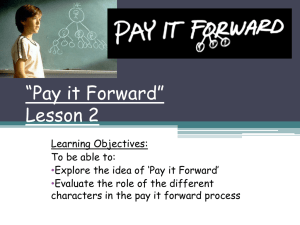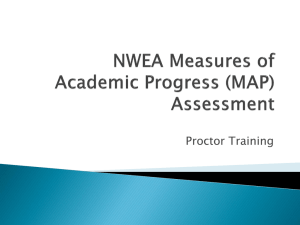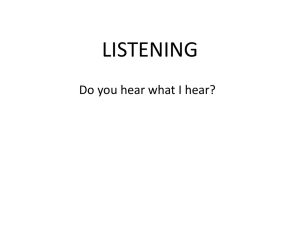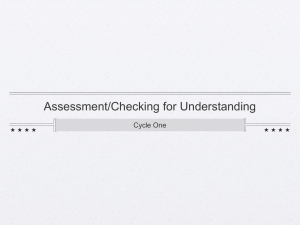Strategic learning in SLA
advertisement
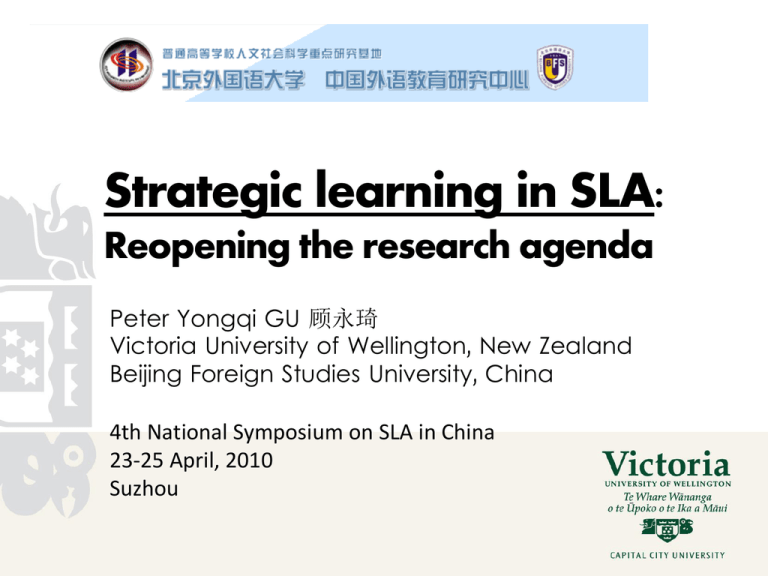
Strategic learning in SLA: Reopening the research agenda Peter Yongqi GU 顾永琦 Victoria University of Wellington, New Zealand Beijing Foreign Studies University, China 4th National Symposium on SLA in China 23-25 April, 2010 Suzhou In this talk… 1. What is strategic learning? 2. Why strategic learning in SLA? 3. Brief recap of 30 years of research on “language learning strategies” 4. Major achievements 5. Problems and proposed solutions 6. Strategic crossroads: Where from here? Part 1: Strategic learning • Strategic learning refers to the learner’s active, intentional engagement in the learning process by selectively attending to a learning problem, mobilising available resources, deciding on the best available plan for action, carrying out the plan, monitoring the performance, and evaluating the results for future action. • Strategic learning is triggered and defined by task demands, and is thus not a task-independent learner trait/capacity. • Strategic learning is tied to a purpose. The purpose of strategic learning is to solve a learning problem, perform a novel task, accelerate the learning rate, or to achieve overall learning success. Part 2: Why study strategic learning in SLA? So long as we – reject a fundamentalist Stimulus-Response view and accept the role of agency in human learning, – agree that cognitive mechanisms play a role in SLA, – agree that, besides individual differences such as aptitude and motivation, learners’ own learning decisions aimed at maximizing results make a difference in the learning process, Strategic learning will need to be examined. Why study strategic learning in SLA? SLA constructs in vogue over the last 30 years: – – – – – comprehensible input opportunities for output corrective feedback task-based presentation Socio-contextual mediation and scaffolding Assumption: Learners will notice the patterns or automatically activate their implicit learning mechanisms Strategic learning: Learners, and teachers, can play a much more active role in managing and controlling the learning process, and thereby maximising the outcomes of learning Part 3 • A brief recap of research on “Language learning strategies” Research on Language learning strategies (LLS) • Exploratory approach – Correlational: Is strategy use correlated with learning results? – Case studies: Do high achievers use different strategies from low achievers? • Intervention approach – Is strategy training effective? Are learner strategies useful? LLS research: Summary of findings 1. 2. 3. 4. There is a quantitative, correlational pattern in general: the more strategies you use, the better; and the more often you use strategies, the better the language performance. However, The quantitative pattern is only at the surface level. The minute you look at specific cases in detail, you immediately realise that it is how a strategy is used, rather than whether it is used that makes a difference. More often than not, it is not how many strategies one uses, it is how a number of strategies are used together and how the learner orchestrates the use of these strategies that makes the real difference, and The choice, use, and effectiveness of strategy use very much depend on who the learner is, what the task at hand demands, and what context the learner is in. LLS research: Examples Study 1 Study 2 Study 3 Think aloud elicitation (Exploring listening strategies) Confirmatory survey (Listening strategies) Strategy training (writing strategies) Study 1: Exploring listening strategies Example: Good listener 1. I: You said you liked the story. Why did you like it? 2. P: (pause 3 sec; looks at wall deep in thought) It (pause 2 sec) tells me about the scenery in the morning. 3. I: OK. 4. P: How it looks like. 5. I: Mm hm. What else? 6. P: (pause 3 sec) Mm (pause 1 sec) the (pause 2 sec) writer gave a very good description of the scenery and (pause 2 sec) other things around him. 7. I: OK. 8. P: (pause 5 sec) And I find it very interesting. 9. I: In what way is it interesting? 10. P: Mm (pause 5 sec) I cannot (pause 1 sec) predict what would happen next. 11. I: Mm. So because you cannot predict, it’s interesting. 12. P: (pause 2 sec) And (pause 3 sec) if I were the writer, I won’t have (pause 3 sec) wrote about the scenery or the stray dogs. 13. I: Mm. And then what would you have written about? 14. P: (pause 5 sec) I’d have written he just jog (pause 2 sec) and went home. --Johnny, Primary 5, High-proficiency Learner Bottom-up decoding Example: Poor listener Mabula left his village early. As usual, he carried his spear and water bag with him. 1. 2. 3. 4. 5. 6. 7. 8. 9. 10. 11. 12. 13. 14. 15. 16. 17. 18. P: (pause 6 sec; thinks and then pouts) Can’t hear it carefully. I: So? P: Again. Rewind. (Replaying the relevant part) P: The … Mabula, I think, is a girl name. I: Hmm. P: (pause 2 sec) He carry a (pause 2 sec), uh she leave her village very early… I: Mm. P: then he carried both bag (gestures carrying bags in both hands) uh the… (pause 1 sec) how to say ah, (pause 2 sec) the beer ah? I: Beer? P: Ya, I think so. (laughter) I: OK. P: I didn’t hear it, that part. I: You didn’t hear that part. So what do you want to do? P: Rewind little bit. I: OK. (Replaying the relevant part) P: Beer and water bag. 0 Sel finiti a ti ng Plan ning Mon itori n g Evalu ati ng Re- li steni ng Ignor i ng Repe t ition Deco ding Infer encin g Pred iction Cont extua lisati on Tran slat io n Imag ery Tran sfer Reco nst ru cti on Sum mar i Per s zati o onal n expe r ience Appr eciat i on o Evalu f text ate u si ng genr Findi e ng pr oblem Usin s g res our ce Coop s erativ e lea rning Askin g f or help Tryi n g to Avoid enj oy ing e mba rrass men t Patterns of strategy use Mean Frequency of Strategy Use by Proficiency Level Top group Bottom group 25 20 15 10 5 Study 1 summary: Listening strategies • Good listeners had a larger repertoire of strategies than poor listeners; • Good listeners used listening strategies more frequently than poor listeners; • Good listeners used both top-down and bottom-up strategies; • Good listeners orchestrated their strategy choice and use; • Poor listeners had fundamental decoding problems; • Some poor listeners used mainly bottom-up decoding strategies; • Some poor listeners used wild guessing to compensate for lack of understanding; • Poor listeners rarely monitored their own strategy use, not to mention any meaningful strategy orchestration. Study 2: Confirmatory survey Listening Strategies Questionnaire Strategy type Strategy Example Metacognitive SelfInitiation Planning I look for opportunities to listen in English. Before I start listening, I decide if I need to pay attention to details or to the main idea. Monitoring If I have a problem in and understanding, I quickly Evaluating decide whether I should continue or listen again. Patterns of listening strategy use 5-point Likert scale, N=3618, Six schools Metacognitive Cognitive Mean SD N Self-Initiation 3.3537 .81629 3543 Planning 3.1877 .91243 3572 Monitoring and Evaluating 3.4178 .74541 3503 Perceptual processing 3.3319 .80994 3469 Inferencing 3.1100 .71942 3507 Predicting 3.0143 .84746 3485 Utilisation/Elaboration 3.2154 .77628 3505 .75276 3492 Social and Socio-Affective Affective strategies 3.2654 Correlations between listening strategies and English language scores SelfInitiation Planning Metacognitive Monitoring and Evaluating r .130(**) p .000 N 3530 r .041(*) p .015 N 3558 r .116(**) p .000 N 3492 Correlations between listening strategies and English language scores Perceptual processing Inferencing Cognitive Predicting Utilisation/ Elaboration r .090(**) p .000 N 3455 r .190(**) p .000 N 3494 r .092(**) p .000 N 3474 r .118(**) p .000 N 3492 Correlations between listening strategies and English language scores Social and Affective SocioAffective strategies r .054(**) p .001 N 3478 Study 2 summary: Listening strategies • Strategy pattern – Most used listening strategies: Monitoring and Evaluating (3.42); Self-Initiation (3.35); Perceptual processing (3.33) – Least used strategies: Predicting (3.01) • Listening strategies and EL results – All strategies significantly correlated with EL results – The highest: Inferencing (r=.190); Self-Initiation (r=.130) – The lowest: Planning (r=.041) Study 3: Strategy-Based Instruction The Singapore Strategy Intervention Project • Coverage: – reading strategies – writing strategies • Length: one semester • Materials: – Reading strategies: Lesson plans package – Writing strategies: Lesson plans package Subjects (Primary 5) Experimental Control School A 2 classes (writing) 2 classes (writing) School B 2 classes (writing) 2 classes (writing) 2 classes (writing) 2 classes (writing) 2 classes (reading) 2 classes (reading) School C Strategy Instruction Framework Teacher Responsibility Preparation Activate Background Knowledge Presentation Attend Participate Explain Model Practice Prompt Strategies Give Feedback Apply Strategies with Guidance Evaluation Assess Strategies Assess Strategies Expansion Support Transfer Use Strategies Independently Transfer Strategies to New Tasks Student Responsibility Chamot, Barnhardt, El-Dinary, & Robbins (1999, p.46) SBI Lessons: Writing Weekly 1 hour sessions Lesson # Writing Strategies 1 Setting writing goals 2 3 4 Planning for content Assessing the audience Getting ideas: reading to find out more 5 6 7 Attending to language at the word level Attending to grammatical structures Writing the essay: orchestrating strategies 8 9 Revising an essay Responding to feedback and revising Structure of an SBI lesson Preparation Presentation Step 1: explaining Step 2: modelling Practice Evaluation Expansion Similar tasks in homework Other EL lessons 5-10 minutes 15 minutes 20-25 minutes 10 minutes Writing scores of experimental vs. control groups Pre Test Groups Experimental Control Mean 47.11 48.85 SD 8.55 6.36 N 119 127 Post Test Total Experimental Control 48.01 52.34 48.08 7.54 7.68 7.10 246 119 127 Total Delayed Test Experimental 50.14 51.42 7.68 6.23 246 119 49.03 50.19 6.27 6.35 127 246 Control Total Plot of mean score differences 53 52 51 Means 50 49 Experimental 48 Control 47 46 45 44 Pretest Post test Tests Delayed test Were the three tests different from each other? Sum of Squares df Mean Square F 821.98 2 410.99 19.85 .000 Tests * Group 1158.12 2 579.06 27.97 .000 Error (Tests) 10103.38 488 20.70 Source Tests Sig. Was the experimental group different from the control group? Source Sum of Squares df Mean Square F 1804408.34 1 1804408.34 16624.59 .000 493.57 1 493.57 4.55 26483.40 244 108.54 Sig. Intercept Group Error .034 Study 3 summary • SBI was found to have made a significant contribution to the writing performance of the experimental group Part 4: Major contributions of LLS research • A large repertoire of language learning strategies has been identified and classified • These LLS have been found to be related to language learning outcomes (mainly to general proficiency, the 4 skills and vocabulary) • LLS patterns of both adult and young learners have been documented from around the world • Effects of LLS on learning have been found to be mediated by a host of person/task/context variables • Strategy intervention has been found useful in boosting learning results Part 5: Problems and proposed solutions – – Constructive criticism Destructive criticism Constructive criticism • Conceptual and theoretical issues – LLS construct too vague and elusive • • • • Static, simplistic either/or lists The size-abstractness dilemma The outside-inside problem Difference between strategic and ordinary learning activity – Research then theory (atheoretical) – The same research questions being asked repeatedly • Methodological issues – Think-aloud intrusive – Survey measures are self-reports only • Practical issues – Not practical enough for immediate use in the classroom – Strategy training results inclusive Destructive criticism • • Destructive criticism – Dörnyei, Z., & Skehan, P. (2003). Individual differences in second language learning. In The Handbook of Second Language Acquisition (pp. 589 - 630). Oxford: Blackwell Publishing. – Dörnyei, Z. (2005). Language learning strategies and student selfregulation. In The psychology of the language learner: Individual differences in second language acquisition (pp. 162-196). Mahwah, New Jersey: Lawrence Erlbaum Associates, Publishers. Destructive action – Tseng, W., Dörnyei, Z., & Schmitt, N. (2006). A new approach to assessing strategic learning: The case of self-regulation in vocabulary acquisition. Applied Linguistics, 27(1), 78-102. – Tseng, W., & Schmitt, N. (2008). Toward a model of motivated vocabulary learning: A structural equation modeling approach. Language Learning, 58(2), 357-400. LLS research: Fate sealed? • “We cannot offer a watertight definition of ‘learning strategies’” (Dörnyei, 2005, p. 166); “learning strategies have contestable validity as a concept” (p. 173). – Hard to pin down the difference between ordinary learning activity and a strategic learning activity – Existing definitions “inconsistent and elusive” • “Simply focusing on the ‘surface manifestations’—i.e., the tactics and techniques that strategic learners actually employ—does not do the topic justice.” (p. 196) • The most often used strategy measure, Rebecca Oxford’s Strategy Inventory for Language Learning (SILL) is psychometrically problematic Dörnyei’s (2005) suggested solution • In educational psychology, “the term learning strategy was first marginalized and then virtually abandoned by the research community in favor of the more versatile concept of self-regulation.” (p. 170) • Self-regulation is a broader, “trait-like strategic potential” (p.190) , “a relatively enduring attribute of a person” (p. 194). • “a new construct, ‘self-regulation’ or ‘self-regulated learning,’ was introduced in the educational psychological literature, and most of the research attention has turned toward examining variables that were more dynamic and process-oriented [My emphasis: How can a trait be dynamic and process-oriented?] than learning/cognitive strategies” The last straw: Tseng, Dörnyei & Schmitt’s (2006) Self-Regulating Capacity in Vocabulary Learning Scale • Actual and explicit attempt in REPLACING the LLS concept in SLA • Dörnyei’s arguments operationalised into a selfregulating trait/capacity with 5 components: commitment control, metacognitive control, satiation control, emotion control, and environment control. • My questions: – Is strategic learning a trait/capacity issue? – Assuming it is, which I hotly debate, can the task of vocabulary learning be reduced to statements like “when learning vocabulary…I…”? Is self-regulation a clear concept? Alexander, P. (2008). Why this and why now? Introduction to the special issue on metacognition, self-regulation, and self-regulated learning. Educational Psychology Review, 20(4), 369-372 • “It is perhaps a truism to say that there is an inverse relation between the popularity of any educational construct and its conceptual clarity within the literature.” (Alexander, 2008, p. 369) • “In fact, it may well be an unavoidable consequence of working within the educational realm that has not precise or agreed-upon meaning for any of its most central constructs.” (pp. 369-370) Dörnyei’s argument for a fuzzy “selfregulation” concept • “Although there are many fuzzy boundaries and distinctions, as well as numerous unresolved issues ranging from the conceptual to the methodological, scholars appear to be keen to invest energy in researching the topic because the stakes have been raised considerably since the time when the target of research was learning strategies only” (Dörnyei, 2005, p. 192). • My reading: – Oh, yeah! We should be keeping up with the fashion in educational psychology, no matter what. – Fuzziness is a sin in SLA, but a virtue in other fields (which must be more scientific than ours) Wisdom from an elder • “In a strange way, language testers ... are not unlike the person who murdered his parents and then made a plea for clemency as an orphan. Our field has been remarkably ahistorical; we have too often satisfied ourselves with patricidal fury on a named or unnamed predecessor before launching ourselves into our own rediscovery of a slightly circular wheel of our own.” Bernard Spolsky (1995) Measured words, p. 352 Part 6: Where from here? Re-opening the research agenda • Build on the strength and knowledge from LLS research Proceed with a complete open mind, both in terms of theorising and in terms of research methodology Aim for complete integration into SLA • • – – Cognitive/neuro-psychological perspectives Sociocultural perspectives Re-opening the research agenda: Cognitive perspectives 1. Reconceptualise static LS as dynamic strategic learning 2. Describe strategic learning in sufficient detail 3. Explain strategic learning a. Open up the explanatory framework b. Explain strategic learning and its relationship to learning outcomes c. Tie strategic learning closely to learning tasks d. Examine the effectiveness of each constituent tactic in relation to task, learner, and learning context Re-opening the research agenda: Cognitive perspectives 4. Study Individual differences in strategic learning 5. Incorporate strategic learning into classroom instruction 6. Expand strategic learning aims to include learner autonomy Dynamic strategic learning Dynamic strategic learning involves at least the following procedures: – Problem identification and selective attention – Analysis of task – Choice of decisions – Execution of plan – Monitoring progress and modifying plan – Evaluating result and deciding on next steps A dynamic view of strategic learning implies: • Strategies can no longer be studied as presence /absence of strategies or frequency of strategy use. • Each of the following can influence learning results: – Selective attention to learning problems and novel tasks – Task analysis – Choice and use of strategies – Monitoring and evaluating of strategies – Flexible orchestration, adaptation and revision of strategic choice and implementation Explaining strategic learning: A person-task-context-strategies framework Context Strategies Person Task Explaining strategic learning • How is strategic learning represented in the mind? • How is strategic learning developed over time? • Does strategic learning make a difference in SLA? • Why does strategic learning make a difference? • How does strategic learning work to make a difference? • How much difference does strategic learning make? Learning task and strategic learning • Traditional learning tasks studied – LLS for language learning in general – LLS for the four skills – LLS for vocabulary • A new agenda for strategic learning should include all aspects of second language acquisition Learning task and strategic learning: What is strategic language learning the learning of? Organizational competence Grammatical Textual competence competence Vocabulary Cohesion, Morphology e.g. Syntax reference, Phonology conjunction Rhetorical organization: conceptual structure for textual effect Pragmatic competence Illocutionary/functional Sociolinguistic competence competence Ability to send and receive Sensitivity to intended meanings to fulfil 4 and control of conventions for macro-functions of language: •Dialect or variety •Ideational: forming, expressing knowledge and •Register feelings •Naturalness •Manipulative: affecting the •Cultural world, e.g., getting things references, done with lang figures of speech •Heuristic: using language to learn, teach, and solve problems •Imaginative: figurative uses of language (Bachman,1990) Learning task and strategic learning • Which aspect of communicative competence? – – – – Accuracy Fluency Complexity Appropriateness Strategic learning beyond communicative competence • Micro-focus: Strategic learning is for the achievement of success in language learning (communicative competence) • Macro-focus: Strategic learning is also for the holistic development of the active, reflective and socially responsible individual (Learner autonomy) Strategic learning at different stages of SLA (Ellis, 1998, p. 43) Re-opening the research agenda: Sociocultural perspectives • Higher forms of human mental activity are always and everywhere mediated by symbolic means • The source of mediation is either a material tool (artifact), a system of symbols (e.g., classroom discourse) or the behaviour of another human being in social interaction • The emergence of strategies is a by-product of goal directed, situated activity in which mediation through artefacts, discourse, or others plays a central role in apprenticing novices into a community of practice. Research from sociocultural perspectives should collect evidence to show … • that strategic learning, rather than solitary, individual activities, is developed in “communities of practice” where inexperienced learners are apprenticed gradually into the sociocultural practices of the classroom community. • that the genesis of learning strategies as objectoriented learning activities and goal directed actions are situated, mediated and shaped by artefacts, discourse, or other people in and out of the classroom. • that dialogic and reflective communities of language learning practice and mediation can lead to the emergence and restructuring of strategies Methodological considerations • Continued exploration with think-aloud elicitation, interviews, diaries, questionnaires. • Much more experimentation – Strategy-Based Instruction of a whole range of needed strategies – Effectiveness of individual strategies in controlled learner-task-context configurations – Classroom experimentation, small-group training, one-on-one tutoring – Laboratory tests of strategic processing, e.g., fMRI scans • Much more classroom integration and action research • Much more narrative enquiry and genetic method that document situated and mediated strategic development • Much more research from emic perspectives, i.e., learners’ own decision making processes in strategic learning, rather than codes imposed by researchers Exploring new methodologies Example: fMRI scans • Strategic vs. non-strategic behaviour (representation): Is strategic processing neurologically different from non-strategic processing? • Development of strategic learning (neural correlates of learning results): Do beginning and experienced strategy users processing the same task show different brain scan patterns? • Strategy transfer to novel tasks: Do brain behaviours show similar patterns in the strategic performance of similar and novel tasks? Criteria for evaluating the new research agenda • Explanatory power: There is no need for one single theory. We need a multitude of perspectives to explore the strategic learning phenomenon. • Usefulness: “No matter a cat is black or white, if it catches mice, it is a good cat.” In other words, research has to yield results that lead to the learners’ more active control of their own learning and to better language learning outcomes. In the spirit of Spring Let a hundred strategy flowers bloom, for the cultivation of a theoretically colourful and practically useful garden nourished by diverse nutrients. Thank you!
